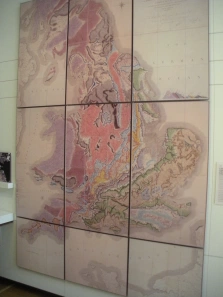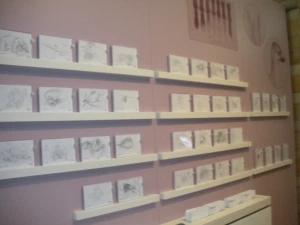Fitting 350 years of studies on nature in a narrow room is an ambitious goal. Eventually, too hard if the aim is to contain highlights from a collection of 500,000 artworks and illustrations, as we can see in “Images of Nature”, the new permanent exhibition of the National History Museum.
The main idea is that art has been the first instrument for classification in the scientific research, including the study of proportions, the illustrations for scientific books and the many records of exotic species from long voyages early in the 18th century.

But without a clear division into sections and a focus on a particular issue, the exhibition closely reminds an antiquarian shop, and most visitors give only a quick look at the walls, before giving up.
Pictures of insects are next to drawings of flowers, fossils and the painting of a rhinoceros. Moreover, there are three microscopes, some satellite images of the surface of Mars, six illustrations of the anatomy of a chimpanzee, three samples of rock types, a pap of England and also the skulk of a dodo.
It’s worth to see the gallery at least for the John Reeves collection of watercolours, which shows 28 samples of the 2,000 zoological and botanical paintings of 1800.
A blue and yellow macaw grabs my attention with its bright colours emerging from a white piece of canvas. In the same display cabinet – which protects the valuable and very delicate works – there are paintings of a black-and-red palm cockatoo, a red lionfish and a group of other fishes from different species. The unknown Chinese artists, whom the tea inspector Mr Reeves commissioned the works, represented the nature in front of them with methodical attention to the particulars. Everything seems to be made by the same hand. There are also drawings of flowers, snakes, a macaque, a lizard and an eagle owl. Though, it’s frustrating to know that the collection is much bigger, but instead of being displayed all together, only some of drawings will rotate every three months.
An interesting section, especially from a scientific point of view, is about the evolution in representing nature, based on the study of anatomy. Two similar paintings of a dodo were exposed next to each other: the first one, set in a wood at nigh time, was made by Roleandt Savery in 1626, while the second one, in the same setting but with daylight, was made by Julian Pender Hume in 2010. Apart from the light and the artistic technique, the very fine differences between the two works are due to a recent discovery on the skeleton of the animal.
The subject of the exhibition is very powerful, but the way it is presented makes it look boring.

What really upsets me, is that as a desperate try to attract people, an entire section is occupied by drawings of children “inspired by the showing”, who are given the chance to draw their own figures and eventually see them exposed. Sorry kids, but that is neither art, nor science. The curators should revise both the distribution of space and priorities.
Images of Nature, National History Museum,
Blue area, at the end of the Dinosaurs’ Way
Open Mon-Sun 10.00-17.50. Free